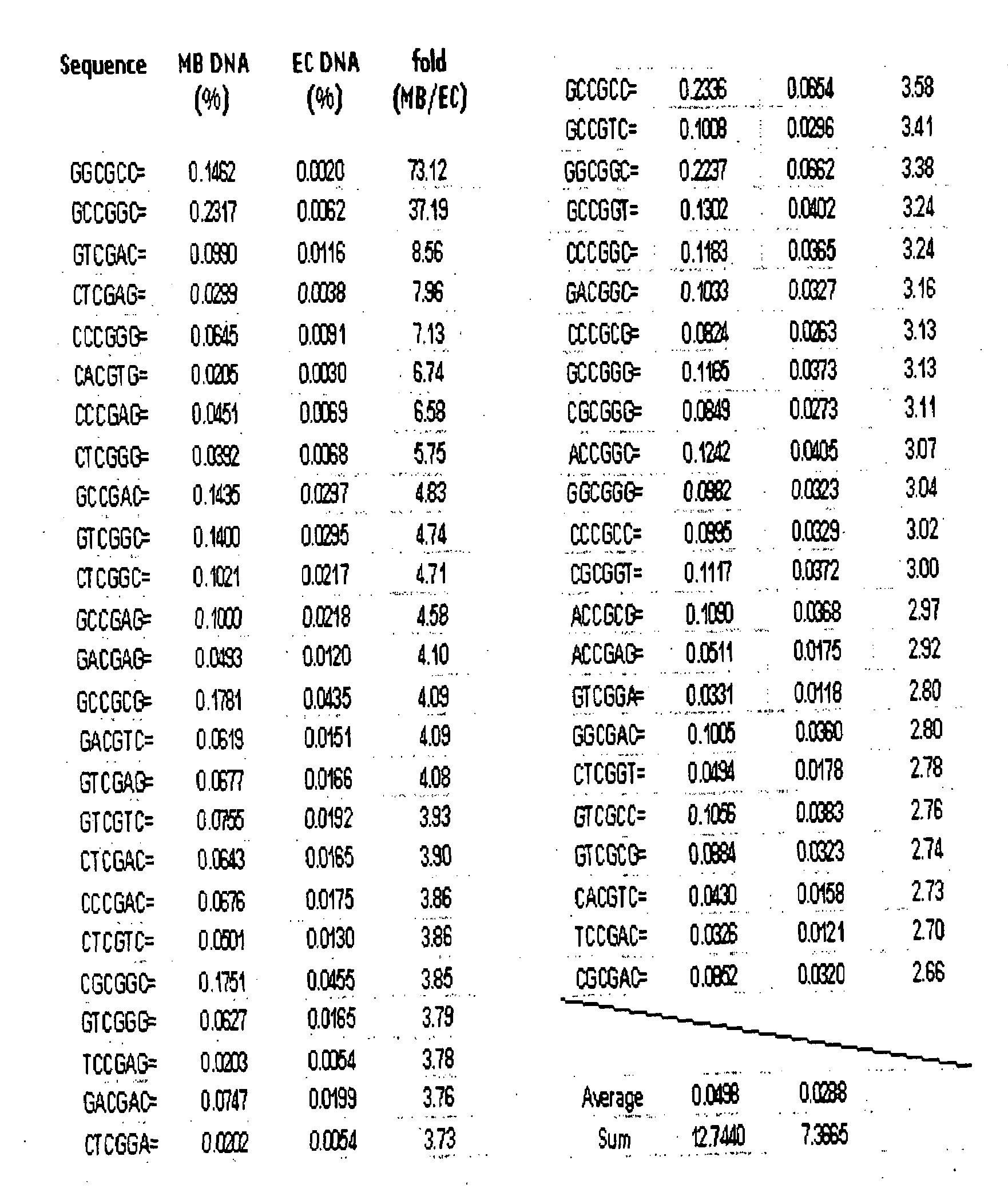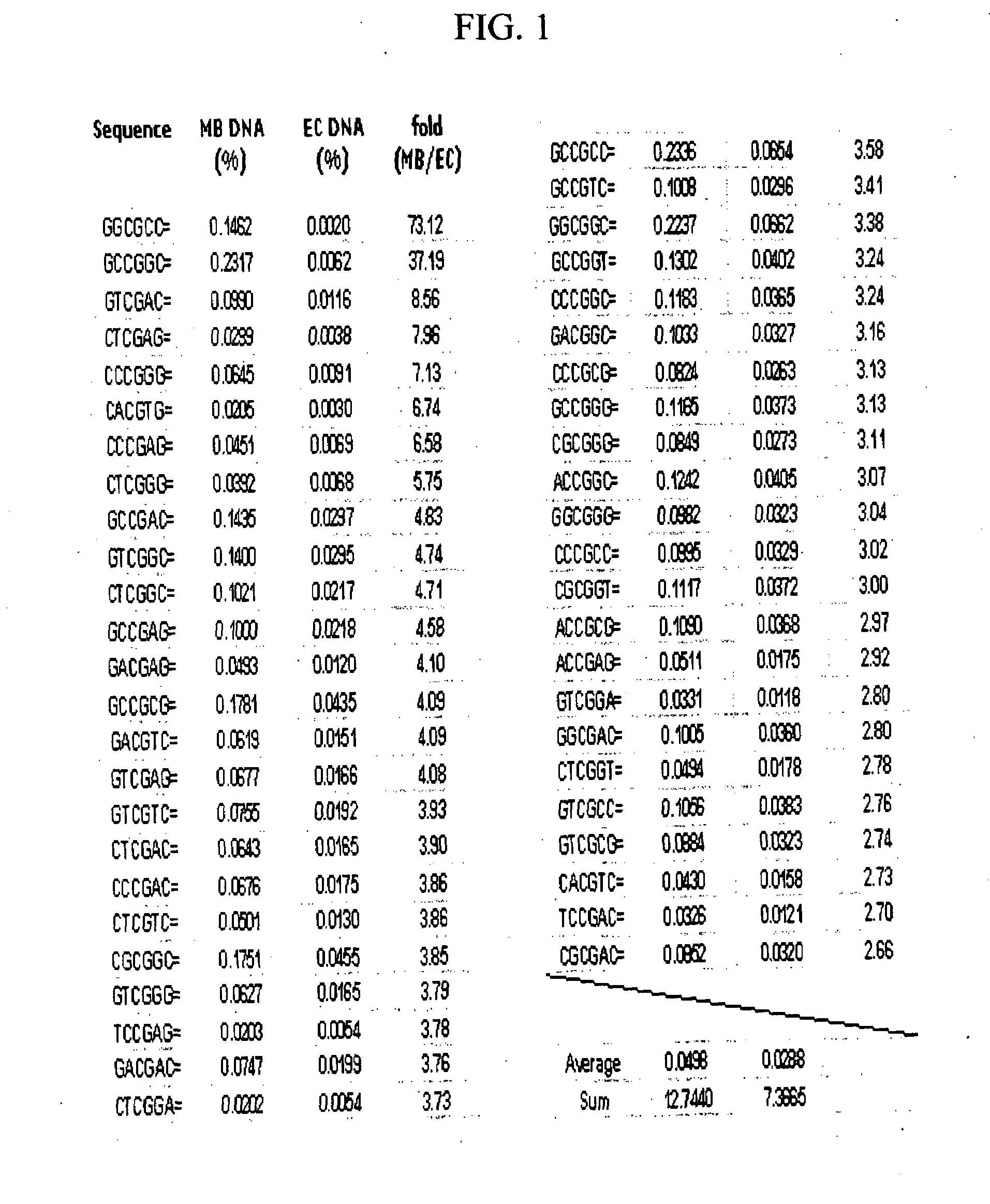Oligonucleotides Derived From Mycobacterium for Stimulating Immune Function, Treating Immune-Related Diseases, Atopic Dermatitis and/or Protecting Normal Immune Cell
a technology of mycobacterium and oligonucleotides, which is applied in the field of mycobacterium oligonucleotides, can solve the problems of inability to easily decompose in vivo, side effects, and destruction of pathogens, and achieve the effects of improving the viability of immune cells, improving symptoms, and increasing expression of bcl-xs/l
- Summary
- Abstract
- Description
- Claims
- Application Information
AI Technical Summary
Benefits of technology
Problems solved by technology
Method used
Image
Examples
example 1
Analysis of DNA Sequences of Chromosomal DNAs from E. coli and M. bovis BCG
[0052] Analysis of DNA Sequences of CpG Motifs in the Chromosomal DNAs from E. coli and M. bovis BCG
[0053]The present inventors analyzed chromosomal DNA sequences of E. coli and M. bovis BCG using a computer program. The frequency of DNA sequences composed of 6 nucleotides, present in the chromosomal DNAs of E. coli and M. bovis BCG, was calculated using the computer program. It was found that the probability of the DNA sequence XXCGXX on the chromosomal DNA is theoretically ¼6, but the probability of the sequence XXCGXX in the chromosomal DNAs of E. coli and M. bovis BCG is actually much higher. Also, it was confirmed that frequency of the sequence XXCGXX in the chromosomal DNA of M. bovis. BCG is more higher than that of E. coli (FIG. 1).
[0054] Analysis of DNA Sequence of CpG ODN in Chromosomal DNA from M. bovis BCG
[0055]20 base pairs of Oligonucleotides were randomly selected from M. bovis BCG chromosomal ...
example 2
Detection of MB-ODN Having Immune Activity
[0057] Immune Reaction of Synthesized Candidate MB-ODNs
[0058]It was examined whether or not the MB-ODNs prepared in the Example , and their various substituents could activate the IL-8 and IL-12 promoters of the macrophages.
[0059]a) Cultivation of Mouse Macrophage
[0060]Raw 264.7 cells (ATCC, Manassas, Va.) were cultured in a DMEM medium including 10% FBS (Gibco BRL). Cell culture was carried out in a 5% CO2 incubator (Form a) at 37° C.
[0061]b) Design of IL-8 and IL-12 Promoter-Luc Reporter Plasmid
[0062]In order to amplify an IL-8 promoter region (from −135 bp to +46 bp), human genome DNA was used as a template, and following primer sets were used to conduct a PCR reaction.
5′ primer (SEQ ID NO: 9)5′-GTGAGATCTGAAGTGTGATGACTCAGG-3′3′ primer (SEQ ID NO: 10)5′-GTGAAGCTTGAAGCTTGTGTGCTCTGC-3′
[0063]A fragment of the amplified IL-8 promoter region was inserted into a pGL3-Basic plasmid (Promega) digested by the restriction enzymes BglII and HindIII. ...
example 3
Modification and Immune Reaction of the DNA Sequence of the Oligonucleotide MB-ODN4 / 5#31
[0072] Modification of DNA Sequence of the Oligonucleotide MB-ODN4 / 5#31
[0073]The DNA sequence of the oligonucleotide MB-ODN4 / 5#31 was modified to synthesize DNA sequences, as described FIG. 6. Each CG sequence of the MB-ODN4 / 5#31 was changed to a GC sequence (#31-CG-1, #31-CG-2, #31-CG-3). Also, the first CG and the second CG were changed to a GC sequence (#31-CG-4), the second CG and the third CG were changed to a GC sequence (#31-CG-5), and the first CG and the third CG were changed to a GC sequence (#31-CG-5). Each base G of the CG sequences was changed to A, T and C, respectively, as shown in FIG. 6a. Also, the first and second CG was changed to the sequence CA, and the second and third CG was changed to the sequence CA, and the first and third CG was changed to the sequence CA.
[0074] Measurement of Immune Reactions by Oligonucleotides Modified from the Oligonucleotide MB-ODN4 / 5#31
[0075]5×104...
PUM
| Property | Measurement | Unit |
|---|---|---|
| pH | aaaaa | aaaaa |
| pH | aaaaa | aaaaa |
| pH | aaaaa | aaaaa |
Abstract
Description
Claims
Application Information
 Login to View More
Login to View More - R&D
- Intellectual Property
- Life Sciences
- Materials
- Tech Scout
- Unparalleled Data Quality
- Higher Quality Content
- 60% Fewer Hallucinations
Browse by: Latest US Patents, China's latest patents, Technical Efficacy Thesaurus, Application Domain, Technology Topic, Popular Technical Reports.
© 2025 PatSnap. All rights reserved.Legal|Privacy policy|Modern Slavery Act Transparency Statement|Sitemap|About US| Contact US: help@patsnap.com



